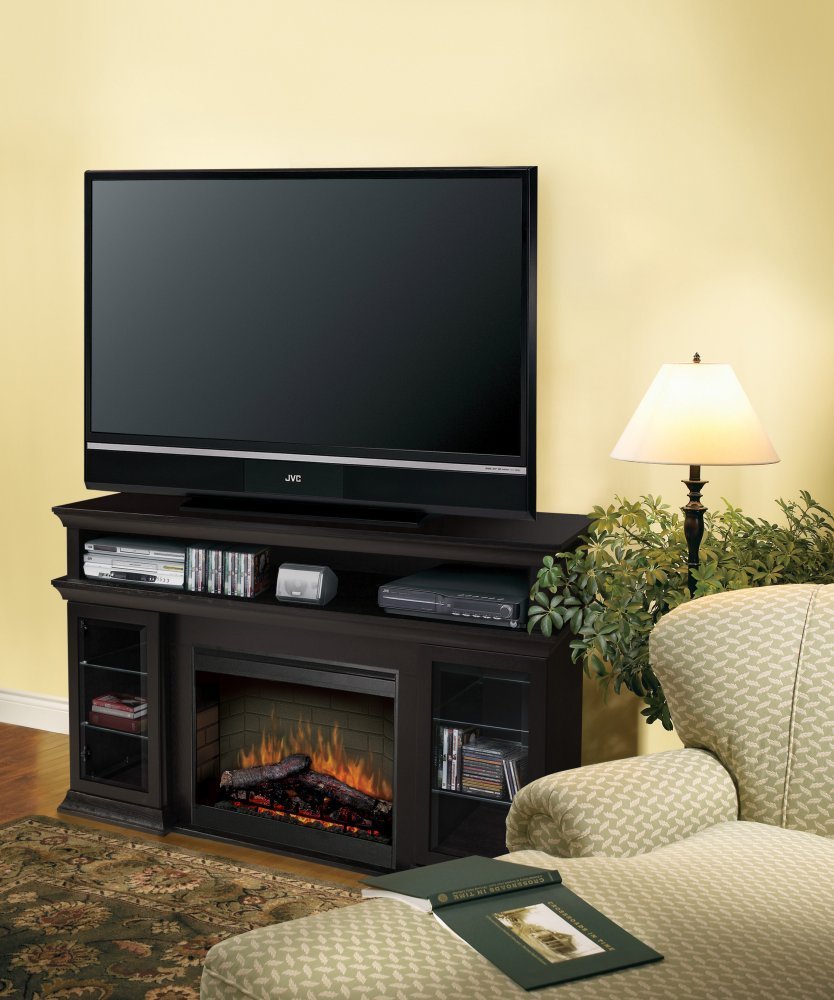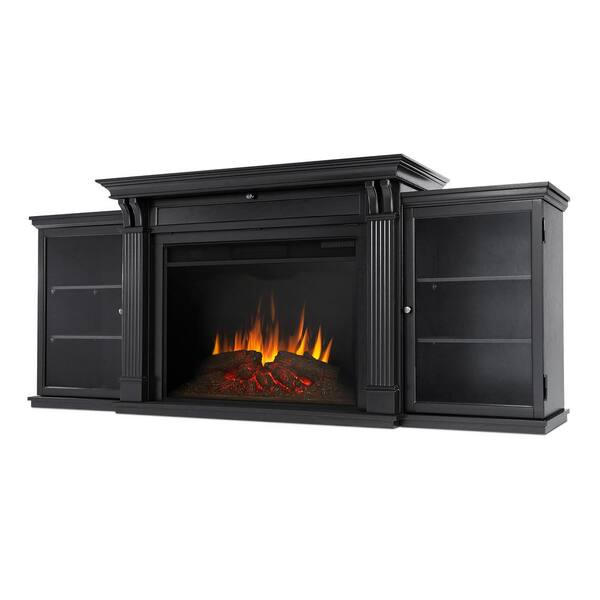Combining an electric fireplace with a TV creates a functional focal point that delivers both warmth and entertainment. This popular arrangement solves multiple design challenges by providing visual interest, supplemental heat, and technology integration in one compact package. Whether you’re remodeling your living room or designing a new media wall, understanding how to properly pair these elements ensures a harmonious and practical result. Here are some considerations for successfully integrating an electric fireplace with your television setup.
Optimal Placement for Viewing and Heating
The relationship between your electric fireplace and TV significantly impacts both functionality and aesthetics. I recommend positioning the TV at eye level when seated, typically 42-60 inches from the floor, with the fireplace directly below. This creates a natural sightline where both elements can be enjoyed comfortably without neck strain. Most electric fireplaces measure 18-24 inches tall, leaving perfect space for a wall-mounted TV above.
Heat distribution matters when planning placement. Electric fireplaces work best when unobstructed, so avoid cramming them into tight media consoles. Allow at least 12 inches of clearance on the sides and 3 feet above for proper airflow. Corner installations can work well if you choose a corner-specific fireplace model and angle the TV appropriately. In open floor plans, I often center the fireplace/TV combo on the longest wall to serve as an anchor for furniture arrangement.
Consider viewing distances when determining proportions. For smaller rooms (under 12 feet wide), a compact electric fireplace with a 55-inch TV creates balanced scale. Larger spaces can handle bigger combinations—I’ve designed media walls with 75-inch TVs above extra-wide linear fireplaces. Always measure your space and tape out dimensions before purchasing to visualize the final look.
Choosing Complementary Styles and Finishes
Your electric fireplace and TV should feel like intentional design partners, not competing elements. For modern spaces, I select linear fireplaces with slim profiles that echo the clean lines of flat-screen TVs. The frame around your television can coordinate with the fireplace surround—black metal fireplace trim pairs well with black TV bezels, while wood finishes create warmth.
Traditional designs benefit from mantel-style electric fireplaces that mimic real wood-burning units. Look for models with realistic flame effects and ember beds to enhance authenticity. When mounting a TV above, I often extend the mantel shelf to create a visual connection between the two. Distressed wood or antique white finishes help traditional fireplaces blend with various TV cabinet styles.
Color temperature affects how well your fireplace and TV appear together. Cool blue flame effects clash with warm TV displays—I prefer fireplaces with adjustable flame colors to match your screen’s tone. Some high-end models even sync flame colors to on-screen content for immersive movie nights. Matte finishes on both surfaces prevent unwanted light reflections during viewing.

Safe Installation Practices for Combined Units
Proper mounting ensures your TV and electric fireplace coexist safely. I always use a stud finder to locate wall framing before installing either component—hollow wall anchors aren’t sufficient for this weight combination. Fireplace manufacturers specify minimum clearance distances between their units and TVs; typically, 12-18 inches is safe for heat-sensitive electronics.
Electrical requirements deserve special attention. Your fireplace and TV should ideally have separate dedicated circuits to prevent overloads. I install a recessed power kit behind the TV to hide cords, with a separate outlet for the fireplace below. Use in-wall rated cables if running wires through walls, and consider a surge protector for both devices. Some electric fireplaces generate electromagnetic interference—keep audio equipment and routers several feet away.
Ventilation prevents heat buildup that could damage your TV. Even though electric fireplaces don’t get as hot as traditional units, prolonged heat exposure can shorten TV lifespan. I often install a slim USB-powered fan behind wall-mounted TVs in these setups for added airflow. Thermal gun readings during fireplace operation help identify any concerning hot spots near sensitive components.
Maximizing Year-Round Functionality
The beauty of electric fireplace/TV combos lies in their four-season usability. During summer, most models allow operating the flame effect without heat, creating ambiance without raising the room temperature. I program smart models to display cool blue flames on hot days, shifting to warm orange hues as seasons change. This maintains visual interest even when heating isn’t needed.
Entertainment modes enhance movie watching. Some electric fireplaces sync flame intensity to audio, pulsing with music or movie soundtracks. Others offer preset scenes like “crackling campfire” for nature documentaries or “gentle embers” for relaxing TV before bed. I disable these features during serious viewing sessions to prevent distraction.
Dual-purpose furniture saves space in smaller rooms. Many media consoles now incorporate electric fireplaces below enclosed TV spaces. These all-in-one solutions work especially well in apartments or condos where built-in options aren’t possible. Look for units with cable management systems to maintain clean lines between the fireplace and television components.
Lighting Considerations for Combined Units
Balanced lighting prevents glare and enhances ambiance. Bias lighting behind the TV—soft LED strips mounted on the wall—reduces eye strain while watching and makes both the fireplace and the screen visuals pop. I set these to warm white (about 3000K) to complement the fireplace glow without color clashes.
Adjustable recessed lighting works well overhead. Install dimmable cans on separate switches—brighter for general room lighting, lower for movie nights. I position these to avoid reflections on the TV screen while still highlighting the fireplace’s texture. Wall sconces flanking the unit can provide reading light without interfering with screen visibility.
The fireplace’s own lighting affects viewing quality. Overly bright flame effects compete with on-screen action—I adjust mine to about 30% brightness during TV use. Some models have a “movie mode” that automatically dims flames when the TV is on. Consider how sunlight interacts with your setup throughout the day; motorized shades help control glare during daytime viewing.
Customizing Your Media Wall Design
Built-in surrounds create polished, integrated looks. I frame fireplace/TV combos with shiplap, stone veneer, or painted millwork for a cohesive unit. Floating shelves on either side balance the composition while displaying decor that doesn’t compete for attention. The key is maintaining negative space around both elements so the wall doesn’t feel overcrowded.
Alternative arrangements break from tradition. In some spaces, I’ve placed the TV beside rather than above the fireplace—this works well with ultra-wide linear fireplaces. Another approach uses a pivoting mount that allows swinging the TV aside to reveal the fireplace as the focal point when desired. These creative layouts prevent the “black rectangle over fire” predictability.
Smart home integration elevates functionality. Voice-controlled fireplaces that sync with home automation systems let you set moods with simple commands. “Movie night” might dim lights, lower the thermostat, and activate fireplace ambiance—all while your TV powers on to the right input. I prioritize systems that allow independent control of fireplace heat and visual effects for maximum flexibility.
How close can I mount my TV above an electric fireplace?
Most manufacturers recommend maintaining at least 12 inches between the top of your electric fireplace and the bottom of your TV. However, this varies by model—some low-heat units allow as little as 6 inches, while others need 18 inches. I always check the specific fireplace’s manual and measure actual surface temperatures during operation. Using a non-heat-conductive mounting bracket adds an extra safety buffer. Proper spacing prevents heat damage to your TV’s components over time.
Do electric fireplaces interfere with TV signals?
Most modern electric fireplaces won’t disrupt TV signals, but exceptions exist. Units with older motorized flame mechanisms sometimes cause electromagnetic interference with antenna or cable signals. If you notice pixelation or signal drops when the fireplace operates, try relocating your antenna or using shielded coaxial cables. Sound systems are more commonly affected—I keep soundbars and receivers at least 3 feet away from fireplaces to prevent audio static or humming.
Can I install an electric fireplace and TV in a bedroom?
Absolutely—this combination works wonderfully in bedrooms. I recommend smaller-scale units for sleeping spaces: a compact electric fireplace (under 36 inches wide) with a 40-55-inch TV maintains proper proportions. Choose a fireplace with ultra-quiet operation (under 40 decibels) and adjustable brightness for nighttime use. Many clients love setting their bedroom fireplace to timer mode—cozy flames that automatically shut off after falling asleep. Just ensure adequate clearance from bedding and window treatments.
What’s the best electric fireplace type for TV pairing?
Low-profile linear electric fireplaces integrate most seamlessly with modern TVs. Their minimalist design doesn’t compete visually, and they provide even heat distribution without hot spots that could affect electronics. For traditional decor, insert-style electric fireplaces inside mantels offer classic appeal. I avoid overly tall or ornate units that force the TV too high for comfortable viewing. Models with adjustable flame speed and color temperature provide the most flexibility to complement different TV content.
How much does a quality electric fireplace/TV setup cost?
Budget 1,500−1,500−5,000 for a complete quality installation. Nice electric fireplaces run 500−500−2,000, depending on size and features. Professional mounting and electrical work adds 300−300−800. The TV cost varies widely—I recommend allocating at least $800 for a decent 65-inch model to pair properly. Built-in millwork or stone surrounds can push budgets higher. While cheaper options exist, investing in proper heat shielding and professional installation prevents costly repairs later.
Should the fireplace or TV be wider?
Ideally, your fireplace and TV should have similar widths for balanced proportions. I aim for the fireplace to be within 10% wider or narrower than the TV above it. A 65-inch TV (57 inches wide) pairs well with a 50-60-inch wide fireplace. For ultra-wide fireplaces, consider flanking the TV with decorative elements like built-in shelves or artwork to visually expand its presence. The goal is to avoid either element appearing disproportionately small or large relative to the other.
Modern Electric Fireplace with TV Wall Mount Unit Ideas
Electric fireplace with tv above ideas fireplace, fireplace
Boston 01 Electric Fireplace Modern 79″ TV Stand (Black)
Blue Flame Fireplace TV Stand
Related Posts:
- Small Free Standing Electric Fireplace
- Electric Fireplaces White Finish
- Limestone Electric Fireplace
- Electric Fireplace Surround DIY
- Electric Fireplace With TV
- The Most Realistic Electric Fireplace
- Chalk Paint Electric Fireplace
- Victorian Style Electric Fireplace
- Electric Fireplace Real Looking Flame
- Amish Mantel Electric Fireplace










